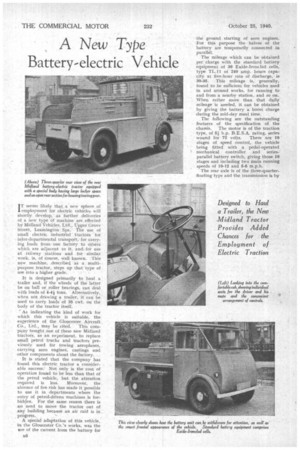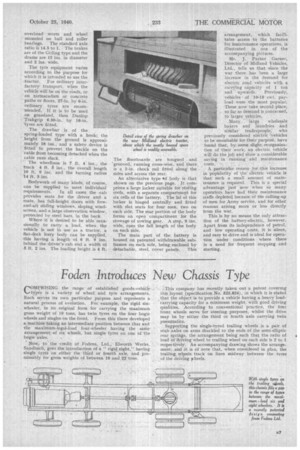• A New Type
Page 24

Page 25

If you've noticed an error in this article please click here to report it so we can fix it.
Battery-electric Vehicle
I T seems likely that a new sphere of
employtnent for electric vehicles will shortly develop, as further deliveries of a new type of machine are effected by Midland Vehicles, Ltd., Upper Grove Street, Leamington Spa. The use of small electric industrial tractors for inter-departmental transport, for carrying loads from one factory to others which are adjacent to it, and. for use at railway -stations and for similar
• work, is, of Course, Well known. This • new machine, described aS a multi-: purpose tractor, steps up that type of use into a higher grade.
It is designed primarily to haul a trailer and, if the wheels of the latter be on ball or roller bearings, can deal with loads of 4-4f tons. Alternatively, when not drawing a trailer, it can be used to carry loads of 35 cwt. on the body of the tractor itself.
As indicating the kind of work for which this vehicle is suitable, the experience of the Gloucester. Aircraft
Co., Ltd., may be cited. This company bought one of these new Midland tractors, as an experiment, to replace small petrol trucks and tractors previously used for towing aeroplanes, carrying aero engines, castings and other components about the factory.
It is stated that the company has found this electric tractor a considerable success: Not only is the cost of operation found to be less than that of the petrol vehicle, but the attention required is less. Moreover, the absence of fire risk has niade it possible to use it in departments where the entry of petrol-driven machines is forbidden. For the same reason there is no need to move the tractor out of any building because an air raid is in , progress.
A special adaptation of this vehicle, in the Gloucester Co.'s works, was the use of the current from the battery for the ground starting of aero engines. For this purpose the halves of the battery are temporarily connected ht. parallel.
The mileage which can be obtained per charge with the standard battery equipment of 36 Exide-Ironclad cells, type TL.il of 240 amp. hours capacity at five-hour rate of discharge, is 30-35. This mileage is, generally. found to be sufficient for vehicles used in and around works, for running to and from a nearby station, and so on. When rather more than that daily mileage is needed, it can be obtained by giving the battery a boost charge during the mid-day meal time.
The following are the outstanding features of the specification of the
chassis. The motor is of the traction type, of 5i h.p. B.E.S,A, rating, series , wound for 72 volts. There are 10 stages of speed control, the vehicle being fitted with a pedal-operated mechanical controller and seriesparallel battery switch, giving those 10 stages and including two main running speeds of 10-12 and 5-6 m.p.h.
The rear axle is of the three-quarterfloating type and the transmission is by overhead worm and wheel • nidunted on ball and roller • bearings. The standard axle ratio is 14.5 to I. The brakes are of the Girling type and the drums are 12 ins, in diameter and 2 ins. wide.
The tyre equipment varies according to, the 'purpose for which it is intended to use the
• tractor, For ordinary interfactory transport, when the vehicle will be on the roads, or on tarmacadam or concrete paths or floors, 27-in. by 6-in. ordinary tyres are recommended. If it is to be used on grassland, then Dunlop
• Trakgrip 6.50-in. by 16-in. tyres are fitted.
The drawbar is of the spring-loaded type with a hook: the • .height from the ground is approximately 16 ins., and a safety device is fitted to prevent the hackle on the cable from becoming detached when the cable runs slack.
• " The wheelbase is 7 ft. 4 ins., the track 4 ft. 5 ins., the overall length 10 ft. 9 ins, and the turning radius '14 ft. 3 ins.
Bodywork of many kinds, of course, can be supplied to meet individual requirements. In all cases the cab provides seats for the driver anda mate, has full-height doors with foreand-aft sliding windows, sloping, windscreen, and a large observation window, • protected by steel bars, in the back. Where it is desired to be able occasionally to carry a load, when the vehicle is not in use as a tractor, a flat-deck lorry body can be supplied, this having a length of 6 ft. 9 ins. behind the driver's cab and a width of 5 ft. 2 ins. The loading height is 4 ft. The floorboards are tongued and 'grooved, running cross-wise, and there,, is a 2-in, chock rail fitted along the sides and across the rear.
An alternative type 4ef body is that shown on the previous page. It comprises a large locker suitable for storing tools, with a separate conipartment for six cells of the battery. The lid of this locker is hinged centrally and fitted with slat seats for four men, two on each side. The rear portion of the body forms an open compartment for the stowage of towing gear. A step, 9 ins, wide, runs the full length of the body on each side.
The main part of the battery is housed on patented withdrawable subframes on each side, being enclosed by detachable, steel, cover panels. This arrangement, which facilitates access to the batteries for Maintenance operations, is illustrated in one of the accompanying pictures.
Mr. J. Parker Garner, Director of Midland Vehicles. Ltd., tells us that since the war there has been a large increase in the demand for electric road vehicles with a carrying capacity of I to and upwards. Previously, vehicles of 10-15 cwt. payload were the most popular. These now take second place, so far as demand is concerned, to larger v.ehicles.
Many large wholesale bakers and laundries and similar tradespeople, who previously considered electric. 'vehicles to be unsuitable for their purpose, have fonnd that, by.some slight reorganization of their work, an electric vehicle will do the job and show a considerable saving in running' and maintenance costs. '
A particular reason for this increase in popularity of the electric vehicle is that such a small amount of maintenance is required. This is a special advantage just now when so many operators have had their maintenance staffs depleted because of the calling-up of men for Army service, and for other reasons arising more or less directly from the war.
This is by no means the only attraction of the battery-electric, however. Apart from its independence of petrol, and low operating costs, it is silent, and easy to drive and is ideal for operation under conditions where there is a need for frequent stopping and starting.




















































